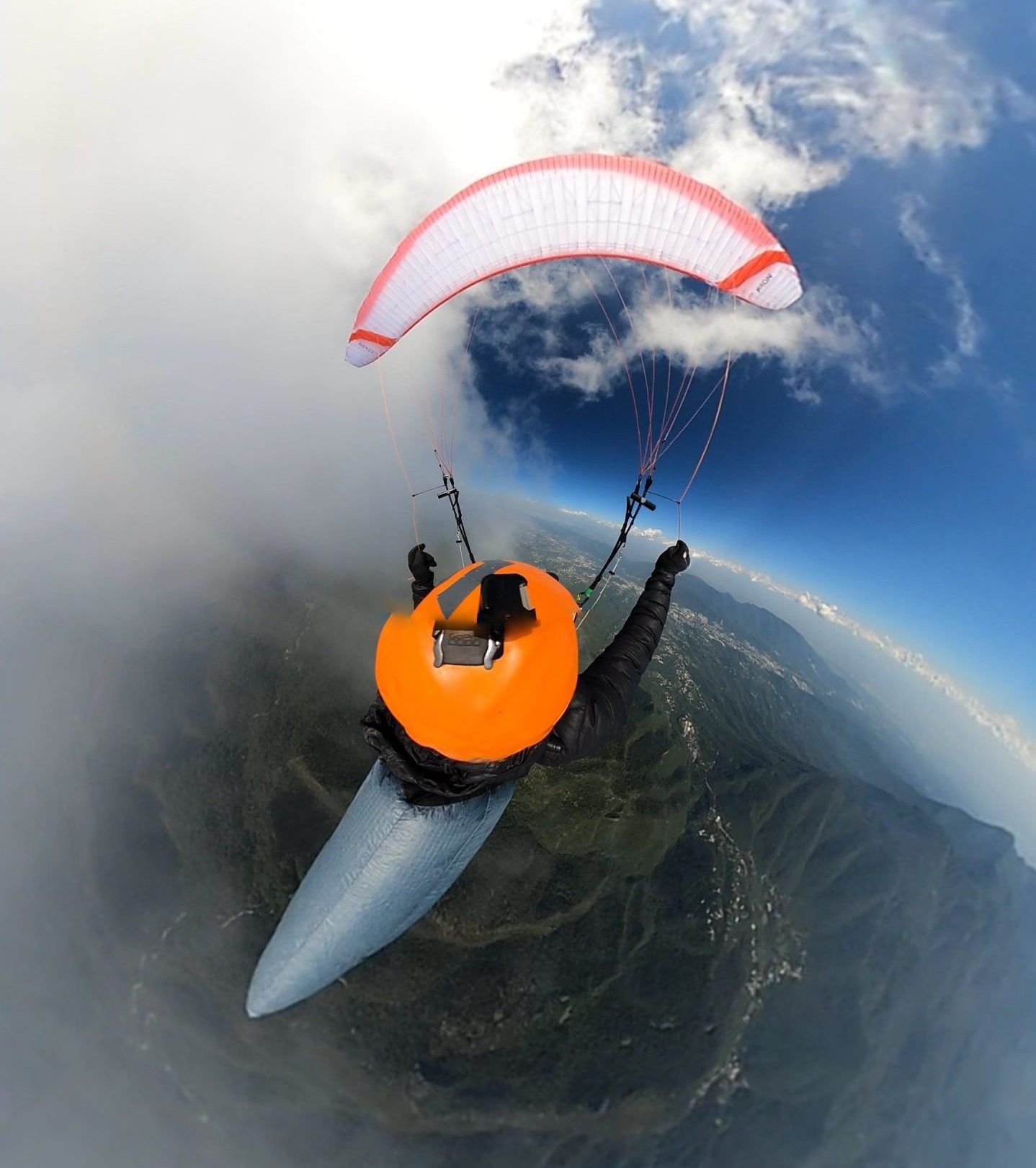
El Peñon, the “Mountain of Destiny” – how I broke a vertebra and what I learned from it…
Nach etwa sieben Monaten Reisen quer durch Nordamerika und Mexiko kamen wir am 24. Oktober endlich an einem meiner lang ersehnten Ziele an: Dem Fliegermekka Valle de Bravo in Mexiko. Lange schon hatte ich mich darauf gefreut, hier zu fliegen – um diese Jahreszeit soll es wegen des verlässlichen Wetters jeden Tag gehen – und das Valle aus der Luft zu erkunden. Leider fiel unser Aufenthalt deutlich anders aus als gedacht und geplant: am zweiten Tag nach der Ankunft hatte ich einen schweren Unfall, der unserem Aufenthalt ein jähes und schmerzhaftes Ende setzte. Wie kam es dazu?
After about seven months of travelling across North America and Mexico, we finally arrived at one of my long-awaited destinations on 24 October: The aviation mecca of Valle de Bravo in Mexico. For a long time, I had been looking forward to flying here and exploring the Valle from the air. At this time of the year, paragliding should be possible every day because of the reliable weather. Unfortunately, our stay turned out much different than expected and planned: on the second day after arrival, I had a serious accident that brought our stay to an abrupt and painful end. How did it happen?
Der Tag des Unfalls begann wie bereits die beiden Tage zuvor mit der Auffahrt zum Startplatz El Peñon. Zu diesem Zeitpunkt war ich mit meiner Freundin Julie sowie unserem gemeinsamen Freund und WG-Mitbewohner Robin unterwegs, der uns in Mexiko „besuchte“. Robin musste um 15 Uhr einen Bus aus dem Valle zum Flughafen in Mexiko City erwischen. Es war also klar, dass wir spätestens um halb drei Uhr in Richtung Valle de Bravo aufbrechen mussten.
The day of the accident began, as the two days before: with the ascent to the El Peñon launch site. At that time, I was travelling with my girlfriend Julie and our mutual friend and flatmate Robin, who was “visiting” us in Mexico. Robin had to catch a bus from the Valle to the airport in Mexico City at 3pm. So, it was clear that we had to leave for Valle de Bravo by half past two at the latest.
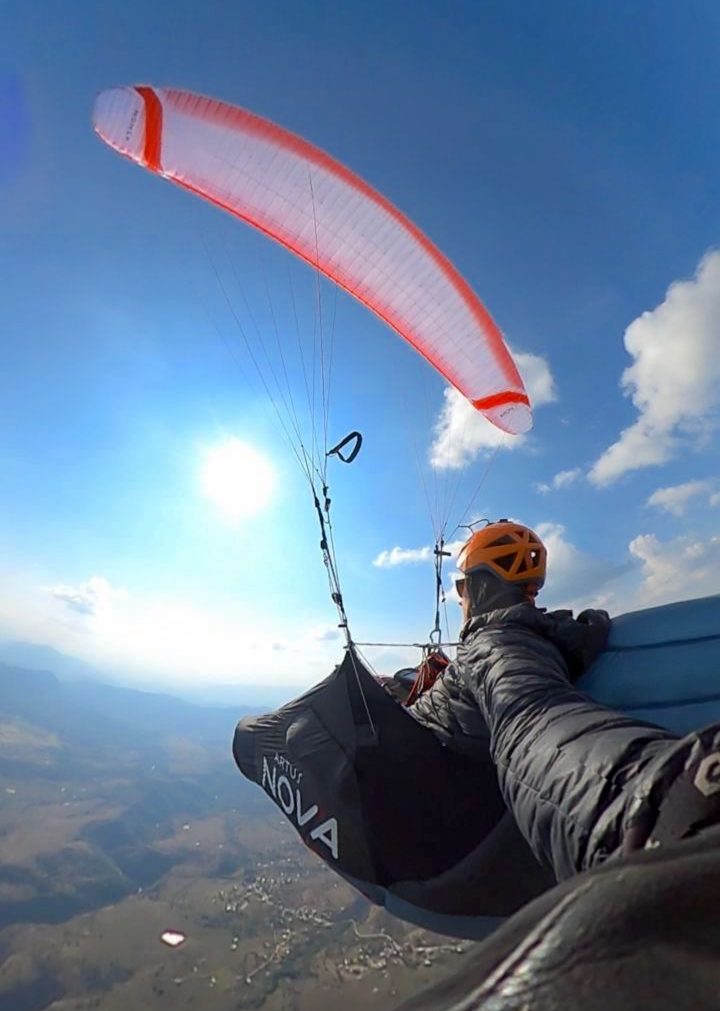
Robin war noch beschäftigt, seine Sachen zu packen und meinte, er könne Julie und mich später am Landeplatz abholen. So konnten wir noch eine Runde im Tandem fliegen. Jedoch hatte ich gerade meinen eigenen neuen XENON erhalten und war scharf darauf, den Schirm zu fliegen. Zuvor hatte ich mir als NOVA-Mitarbeiter immer wieder mal einen XENON-Demoschirm ausgeliehen. Jetzt hatte ich endlich meinen eigenen. Also überredete ich Julie, mich zunächst solo die Luft „antesten“ zu lassen. Gesagt, getan. So ging es also mit dem XENON in die Luft. Die Bedingungen waren gut und ich konnte sogleich aufdrehen. Ich flog einmal die Ridge bis San Pedro entlang und drehte dann um, da ich ein schlechtes Gewissen bekam, Julie warten zu lassen.
Robin was still busy packing his things and said he could pick up Julie and me later at the landing. So, we were able to fly another round in tandem. However, I had just received my own new XENON and was keen to fly the glider. Previously, as a NOVA employee, I had borrowed a XENON demo glider every now and then. Now, I finally had my own. So, I persuaded Julie to let me “test” the air solo first. No sooner said than done. And off I went into the air with my XENON. The conditions were good and I was able to thermal up straight away. I flew once along the ridge to San Pedro and then turned around because I felt guilty about keeping Julie waiting.
Gefühlter Zeitdruck / Sensed time pressure
Zurück über dem Startplatz machte ich mich zum Toplanden bereit. Die Thermik vor dem Startplatz brodelte mittlerweile kräftig – es ging auf Mittag zu. Ich flog mehrmals zum Toplanden an und die Landung hätte bereits beim zweiten Mal gut geklappt, hätte sich mir nicht ein Drachenflieger in dem Weg geparkt, und mich unfreundlich darauf hingewiesen, dass Toplanden am El Peñon nicht erlaubt sei. Meines Wissens nach ist es nicht verboten und ich wollte wegen des Tandemflugs oben einlanden. Ich brach also den Anflug ab, um einen neuen Versuch zu starten.
Back over the launch site, I got ready for a top landing. The thermals in front of the take-off were bubbling away – it was approaching noon. I approached several times and the landing would have gone well the second time if a hang glider hadn’t parked in my way and told me in an unfriendly way that top landings were not allowed at El Peñon. As far as I know, it is not prohibited and I wanted to land at the top because of the tandem flight. So I aborted the approach to try again.
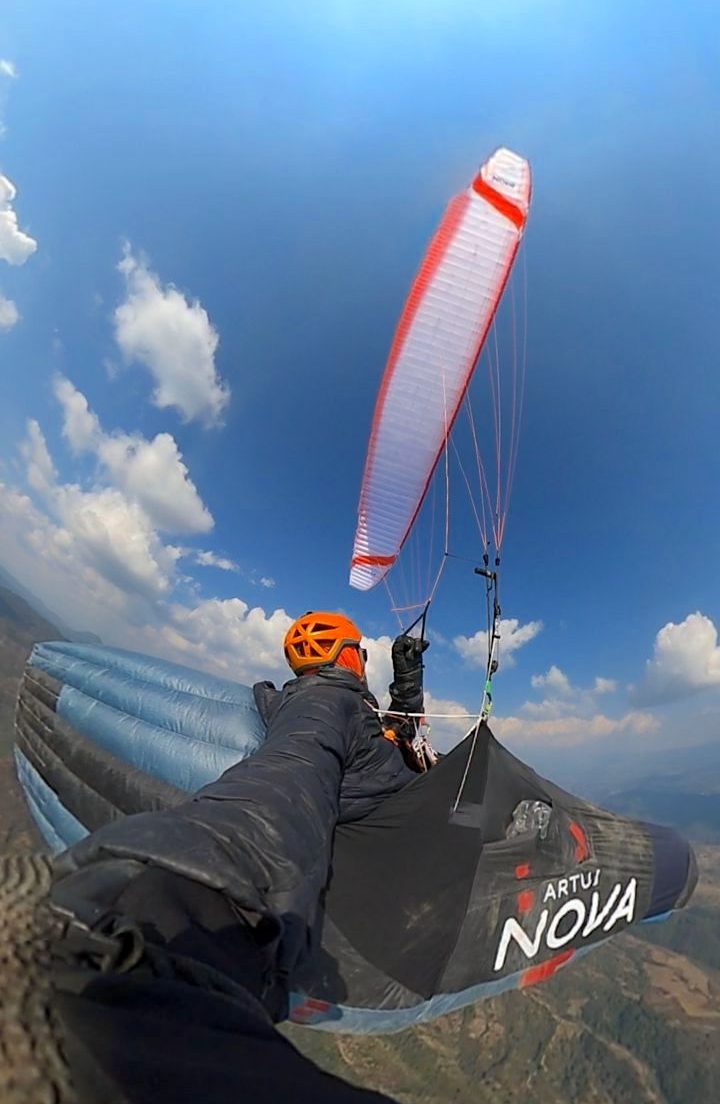
So langsam fühlte ich so etwas wie Stress. Die Uhr tickte und wir wollten doch noch Tandem fliegen. Mein nächster Anflug fiel etwas schlampiger aus. Ich versuchte, mit Überfahrt einlanden, schätzte aber den Pendel falsch ein. Das Resultat war, dass ich am höchsten Punkt des Pendels noch etwa zwei, drei Meter über dem Boden war und aufgrund der Pendelbewegung und des folgenden Vorschießen des Schirms nicht mehr die Landung ohne Bodenkontakt abbrechen konnte. Ich hatte mich in eine Sackgasse manövriert. In dieser Situation entschied ich mich, den Schirm nicht mehr schießen zu lassen, sondern ihn aus zwei, drei Metern herunterzuwürgen. Dieser verzweifelte Versuch endete mit einem harten Einschlag auf der schrägen Wiese.
Slowly, I was beginning to feel something like stress. The clock was ticking and we wanted to fly tandem after all. My next approach was a bit sloppier. I tried to land with excess air speed like “fly on the wall”, but misjudged the pendulum. The result was that at the highest point of the pendulum I was still about two or three metres above the ground and, due to the pendulum movement and the subsequent forward thrust of the glider, I was unable to abort the landing without contacting the ground. I had manoeuvred myself into a dead end. In this situation I decided not to let the glider shoot, but to choke it down from two or three metres. This desperate attempt ended with a hard impact on the sloping meadow.
Glück im Unglück / Lucky in misfortune
Glücklicherweise hatte ich im Gurtzeug bereits die Landeposition eingenommen, sprich, ich hing aufrecht und meine Beine waren aus dem Beinsack heraus. So landete ich zunächst auf meinen Füßen und erst dann auf dem Hintern. Ich spürte sofort starken Schmerz im Rücken und musste zunächst liegen bleiben. Da sich der Unfall am Startplatz ereignete, waren einige andere Piloten, sowie Robin und Julie sofort zur Stelle. Nach einer holprigen Fahrt ins nächste Krankenhaus wurde dort ein Kompressionsbruch des ersten Lendenwirbels diagnostiziert. Zum Glück war der Bruch stabil und musste nicht operiert werden. Der Arzt verordnete mir acht Wochen Ruhe und verschrieb mir ein 3-Punkte Korsett.
Fortunately, I was already in the landing position in my harness, i.e. I was hanging upright and my legs were out of the leg bag. So, I landed on my feet first and only then on my butt. I immediately felt a strong pain in my back and had to stay lying down for the time being. As the accident happened at the take-off, some other pilots, as well as Robin and Julie were immediately on the spot. After a bumpy ride to the nearest hospital, a compression fracture of the first lumbar vertebra was diagnosed. Fortunately, the fracture was stable and did not require surgery. The doctor prescribed eight weeks of rest and a 3-point brace.
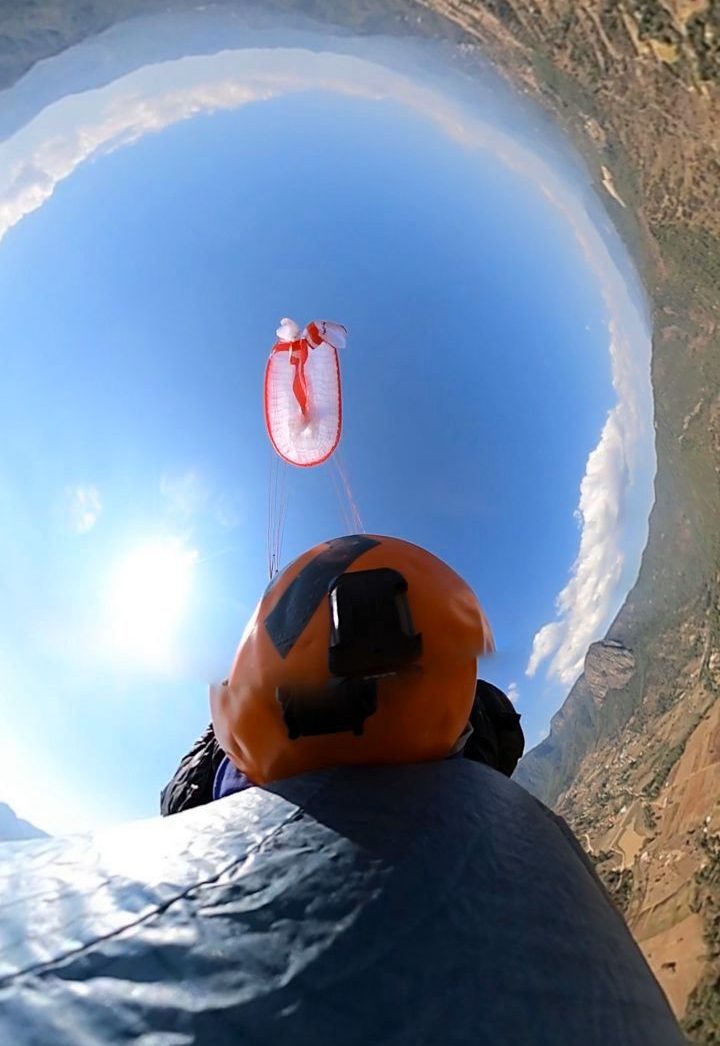
Seither sind exakt acht Wochen vergangen. Ich sitze an einem einsamen Strand im Bundesstaat Oaxaca (Mexiko) und lasse den Unfall noch einmal Revue passieren. Die nüchterne Erkenntnis: Er wäre zu 100 Prozent vermeidbar gewesen! Die Schuld, dass das dazu kam, kann ich nur mir selbst geben.
Since then, exactly eight weeks have passed. I am sitting on a lonely beach in the state of Oaxaca (Mexico) and reviewing the accident. The sober realisation: it could have been 100 per cent avoided! I can only blame myself for the fact that it happened.
Fehleranalyse / Error analysis
- In meinen Augen war das größte Problem der zeitliche Stress.
- Es geschehen generell sehr viele Unfälle beim Toplanden. Man da muss da grundsätzlich extrem vorsichtig sein. Aber eine Toplandung unter Zeitdruck zu erzwingen, ist definitiv eine sehr schlechte Idee.
- Das Bittere an der Angelegenheit war vor allem die Tatsache, dass der Zeitdruck und das Gefühl, jetzt Toplanden zu müssen, nicht der Realität entsprachen. Ich hätte auch einfach entspannt im Tal landen können… Weder Julie noch Robin hätten mir den versäumten Tandemflug übel genommen. Auch zeitlich hätten Robin seinen Bus auf jeden Fall noch erwischt.
- Ich habe die Bedingungen am Startplatz eindeutig unterschätzt. Der Crash geschah um die Mittagszeit bei starker Thermik, die vor dem Startplatz hinauf zog. Der Startplatz selbst ist zwar relativ groß (etwa 300 Meter breit), allerdings ist er von hohen Bäumen umgeben, die es schwer machen sich beim Toplanden von hinten „anzuschleichen“. Man muss also mehr oder weniger mit Rücken- bzw. Seitenwind anfliegen, um einlanden zu können. Starke Thermik bedeutet in diesem Fall auch mehr Rückenwind, was eine Toplandung zusätzlich erschwert.
- Falsche Toplande-Methode: Bei den ersten beiden Versuchen flog ich noch seitlich an und wollte erst im letzten Moment in den Wind drehen. Dies wäre sicher technisch einfacher gewesen und hätte höhere Erfolgschancen versprochen. Beim Unfall wollte ich mit Überfahrt einlanden. Zwar hatte ich diese Art der Landung zuvor an anderen Orten geübt, aber trotzdem bin ich weit davon entfernt, diese Methode an jedem Ort jederzeit sicher umsetzen zu können. So auch am El Peñon – insbesondere bei viel Wind bzw. Thermik. Ich verschätze mich bei der Pendelbewegung und hatte keine Energie mehr in der Kappe, um noch abdrehen oder ausflaren zu können. Der Unfall war also zu diesem Zeitpunkt bereits unausweichlich.
- In my eyes, the biggest problem was the time stress.
- In general, a lot of accidents happen during top landings. You have to be extremely careful. But forcing a top landing under time pressure is definitely a very bad idea.
- The bitter thing was that the time pressure and the feeling of having to top land did not correspond to reality. I could have just relaxed and landed in the valley… Neither Julie nor Robin would have held the missed tandem flight against me. Robin would also have caught his bus in any case.
- I clearly underestimated the conditions at the launch site. The crash happened around lunchtime with strong thermals moving up in front of the launch site. The launch site itself is relatively large (about 300 metres wide), but it is surrounded by tall trees that make it difficult to “sneak up” from behind when top landing. So, you have to approach more or less with a tailwind or crosswind to be able to land. In this case, strong thermals also mean more tailwind, which makes a top landing even more difficult.
- Wrong top landing method: In the first two attempts I flew sideways and only wanted to turn into the wind at the last moment. This would have been technically easier and would have promised better chances of success. In the accident I wanted to land “fly on the wall”. Although I had practised this type of landing at other places before, I am still far from being able to apply this method safely at any place at any time. This was also the case at El Peñon – especially with a lot of wind or thermals. I misjudged the pendulum movement and had no energy left in the canopy to turn or flare out. So, the accident was already inevitable at that point.
Schlussendlich denke ich, dass alle beschrieben Fehler sich in gewisser Weise aufsummiert haben und so zu meinem Unfall geführt haben. Gefühlter Zeitdruck + Bedingungen unterschätzen, um dann eine auch durch Stress unsaubere ausgeführte Toplandung zu absolvieren, mit einer Technik, die ich nicht zu 100% beherrsche. Eine gefährliche Mischung wie mir im Nachhinein schmerzhaft klar wurde. All das musste ich auf dem harten Weg lernen und hatte nun acht Wochen Zeit darüber nachzudenken. Im Nachhinein klängt das alles ziemlich offensichtlich. Aber später ist man nun mal immer schlauer als vorher. Ich hoffe, dass dieser Beitrag dem ein oder anderen von euch hilft, ähnliche Situationen zu vermeiden.
In the end, I think that all the mistakes I described added up in some way and led to my accident. Feeling time pressure + underestimating the conditions, and then making a top landing that was also executed uncleanly due to stress, with a technique that I did not master 100%. A dangerous mixture, as I painfully realised afterwards. I had to learn all this the hard way and then had eight weeks to think about it. In retrospect, it all seems quite obvious. But later you are always smarter than before. I hope this post helps one or two of you to avoid similar situations.
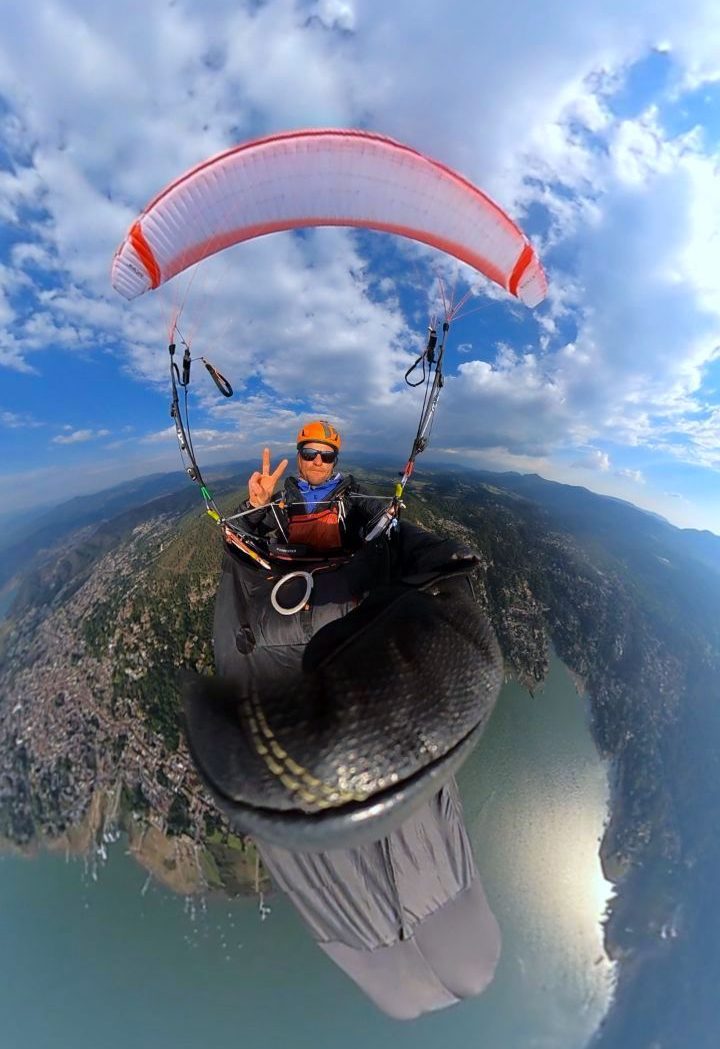
Mein erster Flug nach dem Unfall war ein wunderschöner Sunrise-Soaring-Flug an der wilden Küste von Oaxaca. Ich bin sehr dankbar, wieder in die Luft zu kommen und auch dafür, dass ich nach wie vor keine Angst vor dem Fliegen habe (ist das nun gut oder schlecht?). Meine Motivation ist ungebrochen. Ich freue mich auf jede weiter Flugstunde und hoffe man trifft sich bald in der Luft! Am ehesten wieder ab März im Stubaital. ? Bis dahin alles Gute, vor allem: bleibt gesund!
My first flight after the accident was a beautiful sunrise soaring flight on the wild coast of Oaxaca. I am very grateful to get back in the air and also for the fact that I am still not afraid of flying (is that good or bad?). My motivation is unbroken. I look forward to every new flying lesson and hope to meet you in the air soon! Most likely again in March in Stubaital. ? Until then all the best, and above all: stay healthy!
Paul (Nagl)

Tamas
Feb 2, 2023 -
thanks for sharing. wish you a full recovery and lot of flying times safely.
Marc Delongie
Feb 2, 2023 -
Hello Paul,
Glad all is ok! It must have been a frustrating 8 weeks not being able to fly during the flying season. (My worst nightmare :) )
Good all is over, enjoy your flights now and your new gear!
-marc-